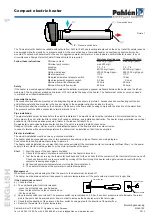
328767-001 www.
americanwaterheater .com 35
BLOWER ASSEMBLY INSTALLATION
1. This power vented water heater comes with blower
assembly installed.
2. After unit is set in place, make sure blower assembly is
still mounted securely. Make sure there is no damage
to blower.
3. Make sure there is no packing material in the inlet or
discharge of the blower.
4. Make sure that the plastic tubing is still attached from
the air pressure switch to the port on the blower motor
housing. Make sure the plastic tubing is not folded
anywhere between the pressure switch and the blower
motor housing (see Figure 36 thru Figure 40).
5. This water heater is a polarity sensitive appliance and
will not operate if the power supply polarity is reversed.
Power to this water heater must be wired properly
(correct polarity).
6. Do not plug in power cord until vent system is
completely installed. The Power Direct Vent operates
on 110 -120 VAC. therefore a grounded outlet must be
within reach of the 6 foot
fl
exible power cord supplied
with the heater. The power cord supplied may be used
on a unit only where local codes permit. If local codes
do not permit use of
fl
exible power supply cord:
a. Make sure the unit is unplugged from the wall
outlet. Remove the screw and open panel on the
front of the junction box on the blower.
b. Cut
the
fl
exible power cord, leaving enough to be
able to make connections. Remove the strain relief
fi
tting from the box.
c. Install a suitable conduit
fi
tting inside the enclosure.
d. Splice
fi
eld wiring into existing wiring using code
authorized method (wire nuts, etc).
e. Be certain that the neutral and line connections
are not reversed when making these connections.
f. Ground heater properly. This water heater must be
grounded in accordance with the current edition of
“National Electrical Code”, NFPA 70
and/or local
codes. These must be followed in all cases. The
water heater must be connected to a grounded
metal, permanent wiring system or an equipment
grounding conductor must be run with the circuit
conductors and connected to the equipment
grounding terminal or lead on the water heater (see
Figure 11; the wiring diagram).
g. Close the panel on the junction box. Make sure
that the access panel is secured shut.
7.
The blower discharge has a rubber coupling made to
accept only straight sections of 2” or 3” pipe. To start
off with an elbow, a short section of the straight pipe
must be cut and glued into the end of the elbow that
will mount in the rubber coupling.
Vent/Intake Pipe Connections To Blower/Air Duct
1. The plastic vent piping connects into the rubber
coupling located on the top of the blower assembly.
This coupling includes gear clamps to connect the
venting to the blower.
Important:
These connections must be properly seated
and tightened to prevent the leakage of
fl
ue gases into the
area. See Figure 36 thru Figure 40.
2. The 40 and 50-gallon heaters with rated inputs of 45k
Btu/hr or less are designed and supplied with a 2”
rubber coupling to accept the vent pipe.
3. The 50 and 75-gallon models with rated inputs of 58k
Btu/hr or more are supplied with a 3” rubber coupling
to accept the vent pipe.
Note:
Polypropylene vent
systems require separate adaptor (
fi
eld supplied).
4. Before installing clean and lightly sand the end of the
ABS/PVC/CPVC plastic vent piping that will connect
into the rubber coupling. For polypropylene vent
systems follow manufacturer’s instructions.
5. Loosen the upper clamp on the rubber coupling and
insert the sanded end of the vent piping a full 1-1/4” .
Do not use glue or sealant in the rubber coupling.
Check that there is no stress on the connection or the
vent piping that may be caused by twisting or bending.
6. Tighten the upper clamp so that the vent piping is
fi
rmly secured in the coupling and is gas tight. Do not
over tighten or cause distortion of any of the parts.
Ensure the bottom of the rubber coupling is
fi
rmly
seated on the blower outlet and that the lower gear
clamp is also secure. Check to ensure there is no
distortion or movement of the clamped assembly once
it is completed.
•
Do not overtighten the top and bottom gear clamps of the
rubber coupling.
•
Do not apply solvent cement or silicone to the rubber
coupling connection.
Property Damage Hazard
CAUTION
HOSE CONNECTION
PORT FOR
CONDENSATE DRAIN
8” LOOP
TO
DRAIN
BLOWER
ASSEMBLY
Figure 35
















































